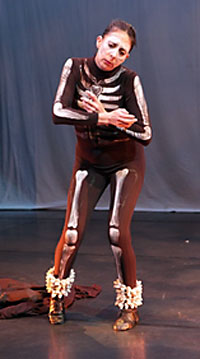|
The Indigenous Performance Initiative in the Nozhem (the Bear) theatre at Trent University in Peterborough, Ontario, Canada, established by Maurie Mumford, the grandmother of First Nations theatre in Canada. IPI promotes original indigenous dance/drama of high calibre. The latest sojourn into imaginative challenges revealed considerable shifts of mood, tone, and imaginative subject matter.
Allegory of the Cranes
Choreographed by Daystar/Rosalie Jones "The Trick" is a "personal ceremony of remembrance", set within the cultural framework of the "Black-footed" people. Daystar was born on the Black Feet reservation in Montana and is a recipient of a National Endowment for the Arts grant for her original indigenous contribution to dance/drama.
Masked characters in the work include Ksistsikomm – a "thunder being" (Keith McFarland), a powerful shape-shifter who can change appearances; Nitsitapiw Aakli ("Alone Woman"- Daystar and Kristina Lewis) a wanderer "no one knows"; and Figures in the Desert (The Saint, a Blind man, a Child/Woman, a Woman with a Caged Peacock, Bird/Snake Woman, and a Gangster). Clearly a crew fit for a theatrical allegory on the pith of the times.
Masks are essential to the stage wizardry, embedded in the scenes, central to the plot, and the shifting nature of the work. Masks also served the purpose of highlighting the fragility of the life process and the difficulty finding one's true "face": the compelling objective of Alone Woman's search for her unmasked self – a challenge.
Alone Woman wanders through a landscape of surreal figures "encountering aspects of herself and her many faces". A double eagle fan, a gift of the Saint (dressed like a nun) and Ksistsikomm, a shape shifter, spurs Alone Woman along to the unveiling of her true face. "The Trick", or Allegory of the Crane, combines medieval like allegory, spiritual overtones, and contemporary indigenous shape shifting ceremony. A brave old world with startling beings in it who appear and reappear at the drop of a prop.
Becoming Namuli
"Namuli" means grandmother in the Yaqui language of the southwest and Mexico. Choreographer/Dancer Norma Araiza has taken on a "difficult and personal journey" through the powerful menopausal years with considerable stage wit. I was intrigued by the revealing power of the work: the subject matter, the flamingo like rhythmical shape shifting, and the imaginative use of petals and feathers symbolic of the transformation into the aging stage of life. Although "Becoming Namuli" revealed the courage it takes to face the reality of a woman's change into "Namuli", the work was staged with a bracing dreamlike, theatrical cognizance.
 |
Araiza is a flamboyant dancer who plays with mood shifts like a iron willed chameleon, moving from one mood to the next with flashy shifts of cognizance. She uses her eyes to trigger a change of mood, and has a tendency to elevate a comic gesture into ironic solidity to sharpen the edges of her dancing. Altogether embracing and humorous, "Becoming Namuli" was a superior stage work highlighting the transformations of aging with considerable grit and wit: a crowd pleaser. Once again the Nozem theatre has become a clearing house for transformative indigenous theatre; without doubt a feather in the Canadian theatrical hat.
Photos - Wayne Eardley
|



